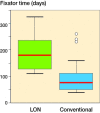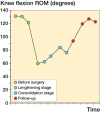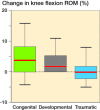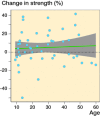Muscle strength and knee range of motion after femoral lengthening
- PMID: 27892743
- PMCID: PMC5385113
- DOI: 10.1080/17453674.2016.1262678
Muscle strength and knee range of motion after femoral lengthening
Abstract
Background and purpose - Femoral lengthening may result in decrease in knee range of motion (ROM) and quadriceps and hamstring muscle weakness. We evaluated preoperative and postoperative knee ROM, hamstring muscle strength, and quadriceps muscle strength in a diverse group of patients undergoing femoral lengthening. We hypothesized that lengthening would not result in a significant change in knee ROM or muscle strength. Patients and methods - This prospective study of 48 patients (mean age 27 (9-60) years) compared ROM and muscle strength before and after femoral lengthening. Patient age, amount of lengthening, percent lengthening, level of osteotomy, fixation time, and method of lengthening were also evaluated regarding knee ROM and strength. The average length of follow-up was 2.9 (2.0-4.7) years. Results - Mean amount of lengthening was 5.2 (2.4-11.0) cm. The difference between preoperative and final knee flexion ROM was 2° for the overall group. Congenital shortening cases lost an average of 5% or 6° of terminal knee flexion, developmental cases lost an average of 3% or 4°, and posttraumatic cases regained all motion. The difference in quadriceps strength at 45° preoperatively and after lengthening was not statistically or clinically significant (2.7 Nm; p = 0.06). Age, amount of lengthening, percent lengthening, osteotomy level, fixation time, and lengthening method had no statistically significant influence on knee ROM or quadriceps strength at final follow-up. Interpretation - Most variables had no effect on ROM or strength, and higher age did not appear to be a limiting factor for femoral lengthening. Patients with congenital causes were most affected in terms of knee flexion.
Figures




Similar articles
-
Treatment of femoral lengthening-related knee stiffness with a novel quadricepsplasty.J Pediatr Orthop. 2013 Jun;33(4):446-52. doi: 10.1097/BPO.0b013e3182784e5d. J Pediatr Orthop. 2013. PMID: 23653036
-
Is Botulinum Toxin Type A a Valuable Adjunct During Femoral Lengthening? A Randomized Trial.Clin Orthop Relat Res. 2016 Dec;474(12):2705-2711. doi: 10.1007/s11999-016-5018-6. Epub 2016 Aug 9. Clin Orthop Relat Res. 2016. PMID: 27506971 Free PMC article. Clinical Trial.
-
Limited quadricepsplasty for contracture during femoral lengthening.Clin Orthop Relat Res. 2009 Nov;467(11):2911-7. doi: 10.1007/s11999-009-0951-2. Epub 2009 Jun 25. Clin Orthop Relat Res. 2009. PMID: 19554383 Free PMC article.
-
Which ROMs Lead to Rome? A Systematic Review of the Effects of Range of Motion on Muscle Hypertrophy.J Strength Cond Res. 2023 May 1;37(5):1135-1144. doi: 10.1519/JSC.0000000000004415. Epub 2023 Jan 18. J Strength Cond Res. 2023. PMID: 36662126
-
Knee strengthening after orthopedics surgery: A comprehensive analysis using key performance indicators to Guide Physical Therapists.F1000Res. 2025 Jan 10;13:1118. doi: 10.12688/f1000research.156922.2. eCollection 2024. F1000Res. 2025. PMID: 40453703 Free PMC article. Review.
Cited by
-
A Comparison of Femoral Lengthening Methods Favors the Magnetic Internal Lengthening Nail When Compared with Lengthening Over a Nail.HSS J. 2018 Jul;14(2):166-176. doi: 10.1007/s11420-017-9596-y. Epub 2018 Jan 5. HSS J. 2018. PMID: 29983659 Free PMC article.
-
Screening Clinical Changes for the Diagnosis of Early Knee Osteoarthritis: A Cross-Sectional Observational Study.Diagnostics (Basel). 2022 Oct 30;12(11):2631. doi: 10.3390/diagnostics12112631. Diagnostics (Basel). 2022. PMID: 36359475 Free PMC article.
-
Sustained hip flexion contracture after femoral lengthening in patients with achondroplasia.BMC Musculoskelet Disord. 2018 Nov 29;19(1):417. doi: 10.1186/s12891-018-2344-8. BMC Musculoskelet Disord. 2018. PMID: 30497473 Free PMC article.
-
Functional recovery of daily living and sports activities after cosmetic bilateral tibia lengthening.Int Orthop. 2019 Sep;43(9):2017-2023. doi: 10.1007/s00264-018-4159-5. Epub 2018 Oct 11. Int Orthop. 2019. PMID: 30311058
-
Results of Wedgeless Distal Femoral Osteotomy for the Treatment of Genu Valgus Deformity.Cureus. 2022 Nov 14;14(11):e31500. doi: 10.7759/cureus.31500. eCollection 2022 Nov. Cureus. 2022. PMID: 36532928 Free PMC article.
References
-
- Acharya A, Guichet J M.. Effect on knee motion of gradual intramedullary femoral lengthening. Acta Orthop Belg 2006; 72(5): 569–77. - PubMed
-
- Barker K L, Simpson A H, Lamb S E.. Loss of knee range of motion in leg lengthening. J Orthop Sports Phys Ther 2001; 31(5): 238–44; discussion 245-6. - PubMed
-
- Boiteau M, Malouin F, Richards C L.. Use of a hand-held dynamometer and a Kin-Com dynamometer for evaluating spastic hypertonia in children: a reliability study. Phys Ther 1995; 75(9): 796–802. - PubMed
-
- Chester R, Costa M L, Shepstone L, Donell S T.. Reliability of isokinetic dynamometry in assessing plantarflexion torque following Achilles tendon rupture. Foot Ankle Int 2003; 24(12): 909–15. - PubMed
-
- Dillon R W, Tis L L, Johnson B F, Higbie E J.. The accuracy of velocity measures obtained on the KinCom 500H isokinetic dynamometer. Isokinetics and Exercise Sci 1998; 7(1): 33–41.
MeSH terms
LinkOut - more resources
Full Text Sources
Other Literature Sources
